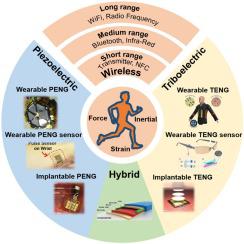当前位置:
X-MOL 学术
›
Nano Today
›
论文详情
Our official English website, www.x-mol.net, welcomes your
feedback! (Note: you will need to create a separate account there.)
Making use of nanoenergy from human – Nanogenerator and self-powered sensor enabled sustainable wireless IoT sensory systems
Nano Today ( IF 13.2 ) Pub Date : 2020-11-07 , DOI: 10.1016/j.nantod.2020.101016 Minglu Zhu , Zhiran Yi , Bin Yang , Chengkuo Lee
Nano Today ( IF 13.2 ) Pub Date : 2020-11-07 , DOI: 10.1016/j.nantod.2020.101016 Minglu Zhu , Zhiran Yi , Bin Yang , Chengkuo Lee

|
Nowadays, the human body is gradually digitized by various wearable and implantable electronics. The establishment of a sustainable wireless internet of thing (IoT) sensory system is urged by developing the energy harvesters and self-powered sensors based on specific scenarios. As one of the dominant energy sources from the human body, mechanical energy offers a great opportunity for piezoelectric nanogenerator (PENG) and triboelectric nanogenerator (TENG) to accomplish the tasks. Both two techniques are featured with simple conversion mechanisms and easy integration for wearable and implantable devices. In this review, starting from the fundamental principle, both wearable and implantable PENG and TENG are thoroughly discussed, with different mechanical stimuli, including force, strain, vibration, ., and various materials, such as ceramic, polymer, textile/nanowires, . Furthermore, based on the outputs from PENG and TENG, the self-powered physical sensors are investigated to exploit the potential of motion recognition or physiological signals monitoring. Besides, the introduction of hybrid systems also provides an overview of the joint function of PENG and TENG for enhancing both power generation and sensing performances. For achieving the IoT sensory network, the representative researches on wireless transmission of both energy and sensing signals are investigated according to the different transmission ranges. In general, this review offers comprehensive knowledge about the recent advances and the future outlook regarding the sustainable wireless sensory system specifically for the human body.
中文翻译:

利用人类的纳米能源——纳米发电机和自供电传感器实现可持续的无线物联网传感系统
如今,人体逐渐被各种可穿戴和植入电子产品数字化。通过开发基于特定场景的能量采集器和自供电传感器,促进建立可持续的无线物联网(IoT)传感系统。作为人体的主要能源之一,机械能为压电纳米发电机(PENG)和摩擦纳米发电机(TENG)完成这些任务提供了很好的机会。这两种技术都具有简单的转换机制,并且易于集成到可穿戴和可植入设备中。在这篇综述中,从基本原理出发,深入讨论了可穿戴和植入式PENG和TENG,以及不同的机械刺激,包括力、应变、振动……以及各种材料,如陶瓷、聚合物、纺织/纳米线等。此外,基于 PENG 和 TENG 的输出,研究了自供电物理传感器,以开发运动识别或生理信号监测的潜力。此外,混合系统的引入还概述了 PENG 和 TENG 的联合功能,以增强发电和传感性能。为了实现物联网传感网络,根据不同的传输范围,对能量和传感信号的无线传输进行了代表性的研究。总的来说,这篇综述提供了有关专门针对人体的可持续无线传感系统的最新进展和未来前景的全面知识。
更新日期:2020-11-07
中文翻译:

利用人类的纳米能源——纳米发电机和自供电传感器实现可持续的无线物联网传感系统
如今,人体逐渐被各种可穿戴和植入电子产品数字化。通过开发基于特定场景的能量采集器和自供电传感器,促进建立可持续的无线物联网(IoT)传感系统。作为人体的主要能源之一,机械能为压电纳米发电机(PENG)和摩擦纳米发电机(TENG)完成这些任务提供了很好的机会。这两种技术都具有简单的转换机制,并且易于集成到可穿戴和可植入设备中。在这篇综述中,从基本原理出发,深入讨论了可穿戴和植入式PENG和TENG,以及不同的机械刺激,包括力、应变、振动……以及各种材料,如陶瓷、聚合物、纺织/纳米线等。此外,基于 PENG 和 TENG 的输出,研究了自供电物理传感器,以开发运动识别或生理信号监测的潜力。此外,混合系统的引入还概述了 PENG 和 TENG 的联合功能,以增强发电和传感性能。为了实现物联网传感网络,根据不同的传输范围,对能量和传感信号的无线传输进行了代表性的研究。总的来说,这篇综述提供了有关专门针对人体的可持续无线传感系统的最新进展和未来前景的全面知识。











































 京公网安备 11010802027423号
京公网安备 11010802027423号